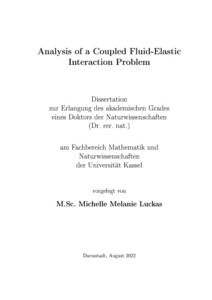| dc.date.accessioned | 2023-01-27T08:01:22Z | |
| dc.date.available | 2023-01-27T08:01:22Z | |
| dc.date.issued | 2023-01 | |
| dc.identifier | doi:10.17170/kobra-202301127372 | |
| dc.identifier.uri | http://hdl.handle.net/123456789/14388 | |
| dc.description.sponsorship | Michelle Luckas wurde von der Studienstiftung des Deutschen Volkes gefördert. | ger |
| dc.language.iso | eng | |
| dc.rights | Urheberrechtlich geschützt | |
| dc.rights.uri | https://rightsstatements.org/page/InC/1.0/ | |
| dc.subject | Fluid-Elastic Interaction | eng |
| dc.subject | Fluid-Structure Interaction | eng |
| dc.subject.ddc | 510 | |
| dc.title | Analysis of a Coupled Fluid-Elastic Interaction Problem | eng |
| dc.type | Dissertation | |
| dcterms.abstract | In this thesis, a non-linear system of partial differential equations is studied, describing the motions of an elastic structure which is immersed into an incompressible viscous fluid. The displacement of the elastic structure is modelled by a Lamé system and the fluid velocity as well as the fluid pressure are described by the Navier-Stokes equations. The structure and the fluid are coupled via two boundary conditions at the interface which correspond to continuity of velocities and forces. As the elasticity is linearized in the Lamé system, the idea of geometric linearization is used to state the equations on constant domains.
In Chapter 2, the existence of local strong solutions to this system is proven. First, the system is decoupled such that the Lamé system can be solved by using a hidden regularity result and a maximal regularity result for the Stokes system can be applied to solve the fluid part. Then an approximation and a fixed point argument are used to construct a local solution to the coupled linearized system. Finally, the solvability of the non-linear system is concluded by applying another fixed point argument. Provided that the initial data are suffciently small, the existence of global solutions is proven in Chapter 3. The proof is based on energy and higher order estimates which can be derived for the system. As a Corollary, it is shown that the fluid velocity converges to zero for large times.
In Chapter 4, the main result of this thesis is stated. It proves that also the elastic displacement converges for large times and that the limit depends on the geometry of the underlying domain. For a large class of good domains, only a stationary part and an artificial rigid velocity remain for large times. If the structure domain is not good (e.g. if it is a sphere), also a pressure wave with a periodic structure can remain. A new method is derived to prove this convergence result: As the elastic displacement is not necessarily globally bounded in L2, convergence of the time derivative of the elastic displacement is shown first, using the structure of the Lamé system as well as the energy estimate of the coupled system. Then the convergence is lifted to the level of the elastic displacement. The main result is first proven for the simpler case of a good domain, before it is extended to any possible geometry. | eng |
| dcterms.accessRights | open access | |
| dcterms.creator | Luckas, Michelle Melanie | |
| dcterms.dateAccepted | 2022-12-16 | |
| dcterms.extent | xi, 80 Seiten | |
| dc.contributor.corporatename | Kassel, Universität Kassel, Fachbereich Mathematik und Naturwissenschaften, Institut für Mathematik | ger |
| dc.contributor.referee | Disser, Karoline (Prof. Dr.) | |
| dc.contributor.referee | Boulakia, Muriel (Prof. Dr.) | |
| dc.subject.swd | Fluid-Struktur-Wechselwirkung | ger |
| dc.subject.swd | Differentialgleichung | ger |
| dc.subject.swd | Lamé-Gleichung | ger |
| dc.subject.swd | Navier-Stokes-Gleichung | ger |
| dc.type.version | publishedVersion | |
| kup.iskup | false | |
| ubks.epflicht | true | |

